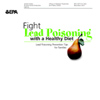- LEAD: Renovation, Repair and Painting Program
 |
 |
 |
 |
 |
 |
 |
 |
 |
In order to better protect children from lead-based paint hazards, EPA has issued new rules for home improvement contractors and maintenance professionals that renovate or repair pre-1978 housing, child-care facilities or schools that contain lead-based paint. Under the new rules, workers must follow lead-safe work practice standards to reduce potential exposure of occupants to dangerous levels of lead resulting from renovation and repair activities. To foster adoption of the new measures, a complementary education and outreach campaign is being implemented to promote the use of lead-safe work practices. |
The rule, “Lead: Renovation, Repair and Painting Program,” requires that contractors and maintenance professionals be certified, that their employees be trained, and that they follow protective lead-safe work practice standards. The new rule prohibits certain work practices that create lead hazards. Trained contractors must post warning signs, restrict occupan ts from work areas, contain work areas to prevent dust and debris from spreading, conduct a thorough cleanup, and verify that cleanup was effective. The rule will affect paid contractors working in pre-1978 housing, child-care facilities and schools, including home improvement contractors, maintenance workers in multi-family |
|
housing, and other specialty trades. The covered facilities include residential, public or commercial buildings where children under age 6 are present on a regular basis as well as all rental housing. The new requirements apply to renovation, repair or painting activities where more than six square feet of lead-based paint is disturbed in a room or where 20 square feet of lead-based paint is disturbed on the exterior. Lead is a highly toxic metal that was used for many years in paint. Lead can cause a range of health effects, from cognitive impairment and learning disabilities, to seizures and death. Children under six years of age are most at risk because their developing nervous systems are especially vulnerable to lead's effects and because they are more likely to ingest lead due to their more frequent hand-to-mouth behavior. EPA's analysis indicates that renovation, repair and painting projects in housing and child-occupied facilities that are likely to contain lead-based paint affect 1.4 million children under age six annually. |